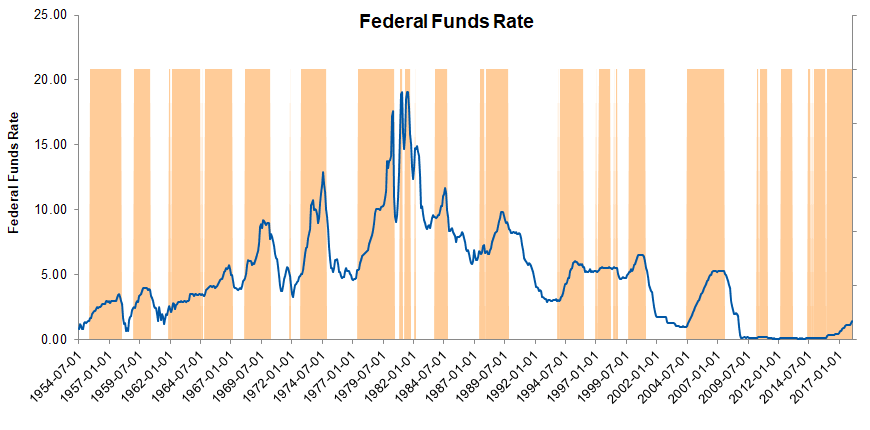The speed of the recent sell-off in stocks has caught many investors by surprise. It’s hard to know what causes stocks to rise and fall over short periods of time, but one factor at play may be that the Federal Reserve has been raising interest rates.
Pundits have been discussing what raising rates means for stocks and your portfolio, but pundits are wrong as often as not. What does the data say?
Check out our H2 hedge fund letters here.
Historical analysis
We looked back at the last 70 years of history and identified every month when interest rates were at all higher than they had been 12 months prior. The chart below shows the history of the Federal Funds rate in the US; the orange bars show each month that meets our criteria (interest rate at time > interest rate 12 month prior). We then studied what happened to the S&P 500 in each subsequent month.
The chart below shows the average S&P 500 return for periods that met our criteria vs. periods that did not. In short, stock gains tend to be 3 times lower during a rising rate environment compared to other environments, but are still positive.
When we dig in deeper we see that while the market does tend to grow less in a rising rate environment on average, there is still historical precedent for it to go up a lot during these periods. The chart below shows the how often different monthly returns occur during a rising rate environment. The chart shows that in 10% of historical cases, the market went up over 5% in a single month in the rising interest rate environment.
What is a risk-averse investor supposed to do?
It makes sense to always be invested in the market and not try to buy or sell based on predictions of when the market is going to go up or down. There is a sea of research that shows that trying to time the market is a fools errand. However, that is likely little comfort to an investor or saver who doesn’t want to lose any of their hard-earned money, but still wants to capture some of the upside the market can offer. Wouldn’t it be great to be protected from the situations where the market goes down, while still participating in some of the gains on the upside?
It actually possible to construct a portfolio where you receive some market upside while being protected from losing any money. You can implement this strategy on your own in a brokerage account or you can sign up for early access to Benjamin. You can learn more about how to do it yourself without our help here.
Article by Sam Abbas
Sam Abbas is the founder of Benjamin. Prior to Benjamin, Sam founded Symmetric.io a software platform to help pension, endowment, foundation & sovereign wealth fund clients get transparency into their hedge funds allocations and better quantify if these investments are providing value. Symmetric is used by many of the largest institutional allocators in the world including 4 of the top 5 fund of funds. Prior to Symmetric, Sam was Director of Research and Trading at Privero Capital, a NYC based trading/technology firm specializing in high frequency statistical arbitrage. Sam began his career as a strategy consultant at Oliver Wyman & Company. Sam graduated from Princeton University with a degree from the Woodrow Wilson School, where he wrote his thesis under Daniel Kahneman, the 2002 Nobel Laureate in Economics.







